ABSTRACT
The present study investigated physiological, mental and physical performance changes during a 20-day winter military training course and the following 10-day recovery period. Fifty-eight (age 19 ± 1 years, height 182 ± 6 cm, body mass 78.5 ± 7.2 kg) male soldiers volunteered. Body composition, serum biomarker levels and performance tests were measured four times during the study. In addition, questionnaires were collected daily for subjective stress and rate of perceived exertion. The course induced significant declines in body (−3.9%, p < 0.05) and fat mass (−31.6%, p < 0.05) as well as in all assessed physical performance variables (−9.2 - −20.2%, p < 0.05), testosterone (−73.7%, p < 0.001) and IGF-1 concentrations (−43.6%, p < 0.001). At the same time, the sex hormone-binding globulin, creatine kinase, and C-reactive protein values increased significantly (46.3–1952.7%, p < 0.05). After the 10-day recovery period, the body composition and hormonal values returned to the baseline (p < 0.05), as did some physical performance variables, such as 2 min sit-ups and the evacuation test (p < 0.05). However, explosive force production in the upper and lower bodies remained unrecovered. The 20-day winter military training caused significant physiological and mental stress, as well as a drastic decline in physical performance even for highly physically fit soldiers, and the 10-day recovery period did not establish full recovery.
KEYWORDS: Cold weather training, military, human performance, endocrinology, recovery
Introduction
Military operations are performed in climatic environments, ranging from very hot (40°C) to extreme cold (−40°C) conditions. Extreme temperatures are not normally a barrier to physical activity, but military operative duties are often performed wearing ballistic protection, which may cause challenges for thermoregulation. Today’s battlefield requires soldiers to have appropriate strength and anaerobic capacity to fulfil the occupational requirements of high-intensity movements with heavy load carriages in various environments [1] [2]. Soldiers in arctic environmental operations face even higher psychological and physiological stressors; these can include drastic energy deficits, sleep restrictions, and extreme weather conditions. When operating in cold environments these stressors can have an even bigger role, due to the weight of cold weather clothing and other equipment. Although the soldiers are exposed to cold air, a critical decrease in core temperature can be avoided with appropriate winter clothing [3]. A downside to this is that the total weight carried is increased; every extra kilogram increases energy expenditure by 3% and every extra layer of clothes increases energy expenditure by 4% [4].
Cold environment impact physical performance in several ways. For example, it causes negative changes in cardiovascular function, nerve conduction, and skeletal muscle contraction. These changes decrease aerobic, anaerobic, and strength/power performance, although the impact of cold exposure on physical performance has not been studied thoroughly [3]. Hackney et al. [5] found that four-day military field training in both hot and cold environments had a negative effect on anaerobic performance measured by the Wingate-test, although cold environments caused larger changes in all measured variables, especially when related to body weight. Previous studies have also shown changes in hormonal biomarkers, such as testosterone, cortisol, IGF-1, SHBG during a prolonged military field training [6–8].
Cahill et al. [9] reported that a decline in core temperature decreased the ability to produce maximal force, but, on the other hand, slowed down fatigue caused by repeated contraction. Galloway and Maughan [10] studied the effect of temperature on aerobic performance and found that the best performance was achieved at 11°C. Higher and lower temperatures resulted a shorter time of exhaustion in the bicycle test. A similar drop in aerobic performance was observed by Sandsund et al. [11] although in their studies the highest time to exhaustion was performed at −4°C. The difference in Galloway and Maughan [10] and Sandsund et al. [11] studies can be at least partly explained by clothing. In the study of Galloway and Maughan [10], the subjects wore shorts and t-shirts, while in the study of Sandsund et al. [11] the subjects wore cross-country skiing clothes, which offered an insulating layer against cold weather. Cold environments have also been found to lower maximal oxygen uptake (VO2max). Oksa [12] reported that oxygen consumption was higher in submaximal treadmill running in the cold, and VO2max was lower in maximal test.
Limitations to aerobic performance and maximal oxygen uptake in the cold can be caused by lower core temperature, decreased muscle temperature and reduced skin temperature [3]. Also, increased blood lactate, lower glucose levels, increased energy expenditure causing larger energy deficits, and increased oxygen consumption with reduced moving economy have been reported to limit physical performance in the cold [3]. These factors have been shown to reduce the maximal heart rate by 10–30 beats, when the body temperature is 0.5 to 2.0 degrees lower. Thirty to 40% reductions in cardiac output and muscle blood flow have also been observed after cold-water immersion [3]. This kind of decrease in core temperature is not desirable and normal during cold weather training and operations.
Similar performance reductions in cold temperatures have been reported for anaerobic, strength, and power performance. Cold affects strength performance and the ability to produce power by decreased contraction speed and nerve conduction velocity, decreased angular speed of the joints, co-activation of agonist-antagonist muscle pairs and EMG activity, and also by enhanced fatigue [3]. Giesbrecht et al. [13] showed that, instead of core temperature, local muscle temperature is the driver for decreased strength. Oksa et al. [14] found that the flight time in rebound jump declined after 60-min exposures to 27, 20, 15 and 10°C air. Davies and Young [15] studied the effect of cold on the force–velocity curve, and found a leftward shift in the curve, demonstrating that with any given force output the velocity is less during cycling exercises with colder muscles. Cold exposure also seems to degrade the ability to maintain both static and dynamic balance [3].
Collectively, the previous literature shows that physical performances, especially aerobic and anaerobic endurance, as well as neuromuscular performance are decreased in very cold weather. These findings are important considerations for soldiers who are performing strenuous duties in arctic climates. During the present study, the subjects practiced and applied their military and survival skills in arctic environment and were exposed to strenuous physical and psychological stress. The aim was to investigate physiological changes in paratroopers during a 20-day winter military training course and the following 10-day recovery period.
Methods and design
The study was conducted during a winter military exercise in northern Finland above the Arctic Circle. The military field exercise (MFT) consisted of two phases; the first phase included basic skills training (skiing, shooting, etc.) lasting 10 days in winter conditions, while the second phase started with a parajump with all their equipment into the arctic wilderness and continued with reconnaissance and other military tasks lasting 10 days. At the end of the training course, participants performed a strenuous 24-hour ski march. Physiological and hormonal measurements were performed four times (PRE, MID, POST, RECO) during the study (Figure 1). In addition, self-assessments for sleep duration, subjective demand level, and the rate of perceived exertion were collected daily.
Figure 1.
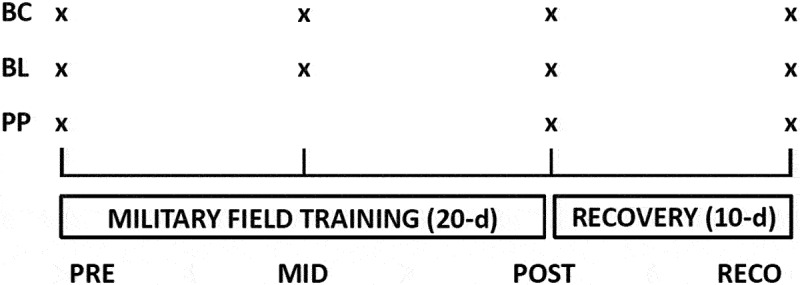
Study design and measurement points. BC = Body Composition measurements; BL = Blood samples; PP = Physical Performance measurements.
The weather data during the exercise was collected from the Finnish Meteorological Institute (https://en.ilmatieteenlaitos.fi/download-observations) and are shown in Table 1 for the beginning of exercise (0–10 d), the later part of the exercise (11–20 d) and for the whole exercise (0–20 d).
Table 1.
Weather details during the exercise.
| 0–10 d | 11–20 d | 0–20 d | |
|---|---|---|---|
| Average snow depth (cm) | 92 | 79 | 85 |
| Average daily temp (°C) | −14.5 | −5.2 | −9.6 |
| Average daily max temp (°C) | −6.5 | −0.7 | −3.5 |
| Average daily min temp (°C) | −22.6 | −12.8 | −17.5 |
Participants
A total of 58 (age 19 ± 1 years, height 182 ± 6 cm, body mass 78.5 ± 7.2 kg) male soldiers voluntary participated in a 20-day military field training course (MFT). The present study was conducted according to the provisions of the Declaration of Helsinki and was granted approval from the Ethical Committee of the University Hospital of Helsinki (HUS/1020/2019). The study was given an approval by the Finnish Defence Forces (AP12498). All subjects were informed of the experimental design, and the benefits and possible risks that could be associated with the study prior to signing an informed consent to voluntarily participate in the study.
Anthropometrics
Body composition and serum hormone concentrations were measured before the MFT before the most demanding part of the MFT, immediately after the MFT, and 10 days after the MFT (PRE = day 0; MID = day 10; POST = day 20; RECO = day 30). Body composition was assessed via segmental multifrequency bioimpedance analysis (InBody 720/770, Inbody Company Ltd, Seoul, South Korea) the morning before breakfast. The device measures body composition by sending multiple electrical currents through the body. These currents are conducted differently through the extracellular and intracellular water of the body as a function of the current frequency and with these result estimates of fat and muscle mass for the trunk and each of the four limbs can be produced. McLester et al. [16] reported high reliability values for estimation of FATM (ICC 0.98, SEM 0.87), FAT% (ICC 0.98, SEM 0.99) and SMM (ICC 0.99, SEM 0.84) by this method in males.
Physical performance
The subjects performed a series of physical performance tests including standing long jump, countermovement jump, medicine ball throw, weighted chin-ups, 2 min repetitive sit-ups, and casualty evacuation test three times during the study (Figure 1). The tests were performed in the same order at all measurement points. A 10-minute supervised warm-up preceded the physical tests. In the standing long jump (SLJ), subjects were instructed to jump as far as possible for the best result on a rubber mat with integrated measuring scale. A total of three attempts were allowed, and the best jump was taken into analysis. The medicine ball throw (MBT) was performed from a seated position with shoulders, and the back of the head against a wall and legs straight on the ground while throwing. Three attempts were also given and the best throw was taken into analysis. The countermovement jump (CMJ) was performed with a contact mat (Newtest, Oulu, Finland). Participants were instructed to keep their hands on their waists during the jump, and knees and ankles were to be extended during the landing. The best of the three jumps was taken into analysis. The weighted chin-ups (PU) were performed with a 10 kg weight on the waist until exhaustion. The total number of repetitions was taken into analysis. In the sit-up (SU) test, the participants performed as many repetitions as possible in two minutes. An assistant held the subject’s ankles during the test, and shoulder plates had to make a contact with the ground in the bottom/down position, and in the top position, elbows were to touch the knees. A standardised evacuation test (EVAC) was used after all other physical tests. In short, this test measures the time to evacuate a 70 kg doll wearing a 10 kg plate carrier on a 10 × 20 m course with total work time around 40–50 seconds [17].
Serum biomarker levels
Venous blood samples were drawn from the antecubital vein after an overnight fast before breakfast four times (PRE, MID, POST, and RECO) during the study. Samples were centrifuged (Megafire 1.0 R Heraeus, DJB Labcare Ltd, Buckinghamshire, UK) at 2000× g for 10 min and frozen for a later analysis. Immulite 2000 ×PI immunoanalyzer (Healthcare Diagnostics Products Ltd.) was used to analyse cortisol (COR), testosterone (TES), insulin-like growth factor-1 (IGF-1) and C-reactive protein (CRP) concentrations. Indiko Plus chemistry analyser (Thermo Fisher Scientific Ltd.) was used to analyse creatine kinase (CK). The sensitivity and interassay coefficients of variance for these assays were 5.5 nmol/L and 6.5% for COR, 0.5 nmol/L and 7.8% for TES, 2.6 nmol/L and 7.8% for IGF-1, 0.08 µmol/L, 0.1 mg/L and 7.3% for CRP, and 7 U/l and 7.1% for CK.
Statistics
Statistical analysis were conducted in R v 4.1.2 (R Core Team [18]) with packages rstatix (CRAN – Package lmerTest (r-project.org)) for ANOVA, and with ggpubr (CRAN – Package ggpubr (r-project.org)) for correlations. All data were checked quantitatively and visually for normality and logarithmic transformation were performed for skewed, non-normal variables. The data are presented as means with standard deviation and confidence intervals (95% CI) when appropriate. The level of significance was set 95% confidence (p < 0.05). Repeated measure analysis of variance was performed to inspect dependency between measured (logarithmically transformed) test result values at different time points. Variances were equal (Levene’s test) at different time points (PRE, MID, POST, RECO). All data were examined quantitatively and graphically.
Results
Rates of perceived exertion, sleep time, and NASA-TLX questionnaire were used to evaluate daily subjective physical strain. As seen in Figure 2, the participants rated the last part (the portion between MID and POST) of the winter training exercise as quite demanding, both physically and mentally. During this time period, the average amount of sleep was 4.6 ± 2.2 hours per night.
Figure 2.
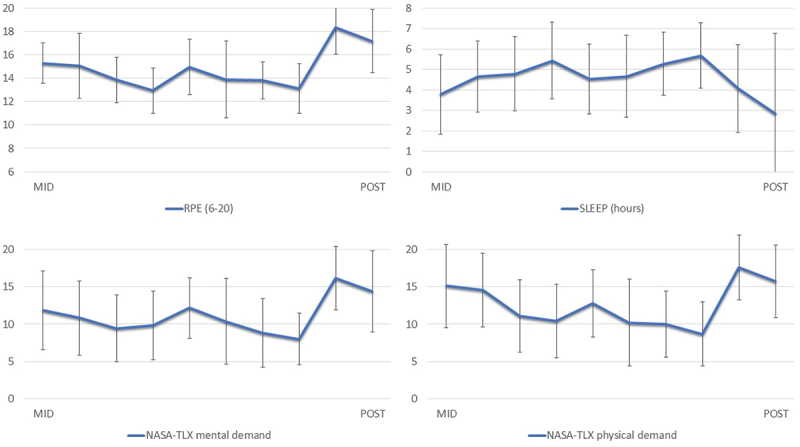
Subjective rating of perceived exertion (RPE), sleep, mental, and physical demand during the last part of the military exercise.
Participants’ body mass (PRE 78.5 ± 7.4 kg; MID 78.2 ± 7.3 kg; POST 75.6 ± 7.1 kg; RECO 78.9 ± 7.3 kg) and fat mass (PRE 9.0 ± 2.4 kg; MID 8.0 ± 2.3 kg; POST 6.2 ± 2.0 kg; RECO 9.2 ± 2.2 kg) declined during the field training but recovered to PRE-values after a 10-day recovery period (Figure 3). A large mean change in fat mass was observed from PRE to POST (2.8 ± 1.5 kg, p < 0.01).
Figure 3.
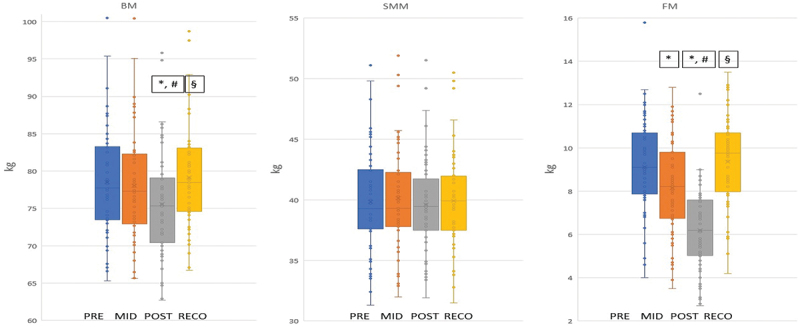
Anthropometric changes during the military exercise. BM=body mass, SMM=skeletal muscle mass, FM=fat mass. * = compared to PRE-value, *=p<0.05; # = compared to MID-value, #=p<0.05; § = compared to POST-value, §=p<0.05.
The 20-day MFT induced a significant decline in all measured variables of physical performance. Sit-ups (PRE 70.3 ± 11.3; reps/2-min POST 60.1 ± 13.0 reps/2-min; RECO 67.6 ± 11.6 reps/2-min) and evacuation test (PRE 49.8 ± 5.6 s; POST 60.4 ± 10.5 s; RECO 51.5 ± 5.5 s) were close to PRE values after a 10-day recovery period, but medicine ball throw (PRE 650 ± 73 cm; POST 581 ± 70 cm; RECO 591 ± 69 cm), standing long jump (PRE 240 ± 17 cm; POST 211 ± 25 cm; RECO 222 ± 17 cm) and counter movement jump (PRE 40.5 ± 5.3 cm; POST 36.6 ± 5.5 cm; RECO 35.5 ± 4.5 cm) did not recover to PRE-values during the 10-day recovery period (Figure 4).
Figure 4.
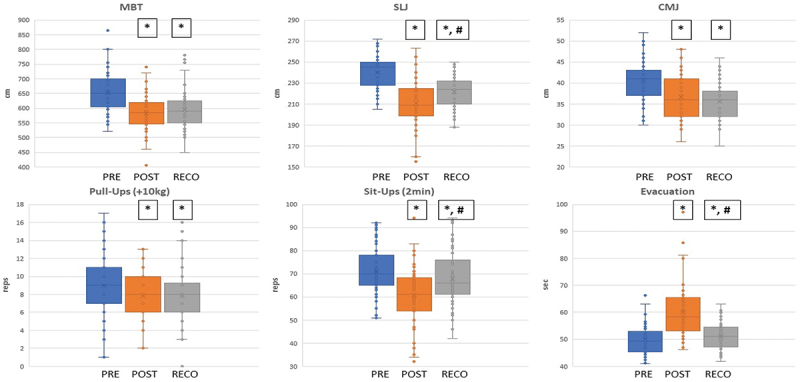
Physical performance changes during the military exercise. MBT=medicine ball throw, SLJ=standing long jump, CMJ=counter movement jump. * = compared to PRE-value, *=p<0.05; # = compared to MID-value, #=p<0.05.
There was a significant decline in TES (−72%), and IGF-1 (−43%) values and significant increases in SHBG (45%), CK (2045%), CRP (2408%) from PRE to POST during the winter military exercise. All measured values returned to PRE-level after a 10-day recovery period (Figure 5).
Figure 5.
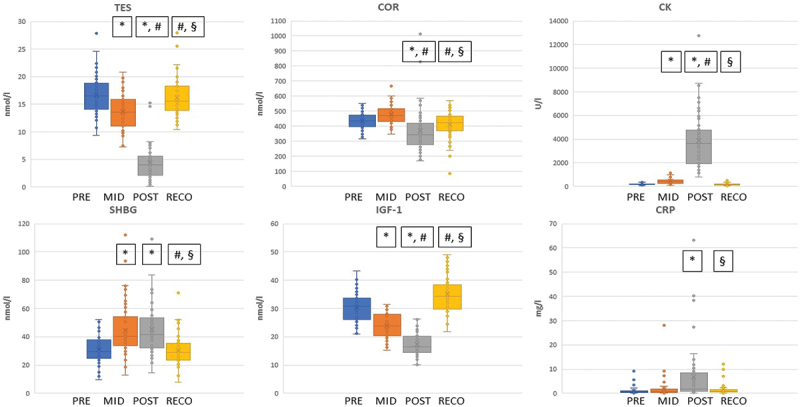
Biochemical changes during the military exercise. TES=testosterone, COR=cortisol, CK=creatine kinase, SHBG=sex hormone binding globulin, IGF-1=insulin like growth factor-1, CRP=c-reactive protein. * = compared to PRE-value, *=p<0.05; # = compared to MID-value, #=p<0.05; § = compared to POST-value, §=p<0.05.
Discussion
The 20-day strenuous winter military training caused significant physiological and mental stress, as well as drastic decline in physical performance even for highly physically fit soldiers, and the 10-day recovery period did not establish full recovery in all measured variables. Explosive force production remained unrecovered, whereas hormone concentrations and body composition recovered fully. Previously, it has been reported that prolonged operational stress leads to decrements in physical performance [19,20], and full hormonal recovery after a strenuous winter expedition to the North Pole [21] occurred after 2 recovery weeks. Also, after a 20-day military training in summer conditions, 4-day recovery period was adequate for the return of hormone concentrations to baseline [8]. On the other hand, this kind of physiological stress also influences the circadian cycles of hormones. Although the hormone values may return to baseline quite fast, Opstad [22] found that after a short but demanding 5–day military training including severe sleep and energy deprivation, the circadian rhythm of different hormones did not return to baseline within a 5–day recovery period. Also, Rognum et al. [23] found that a military field exercise with a high energy deficit caused a similar significant fat mass loss as in the present study. They force-fed half of the soldiers, but it only partially decreased tai prevented from fat loss. In a study by Frykman et al. [24] during a prolonged (3000 km) Greenland expedition, 6000 kcal/day energy intake was shown to maintain body composition and physical performance. According to this finding, it might be possible to maintain performance also during strenuous military field training in cold environment with a very high energy intake. Altogether, these homoeostatic disturbances and their implications for human performance are important considerations for future studies to focus on, especially energy deficit, which causes hormone reductions and performance decrements. Avoidance of energy deficit in the field to prevent such reductions is an important research topic in the future. Loss of muscle mass was not observed in the present study, but if similar energy deficit would have continued, a decrease in muscle mass and even greater decrease in performance would have been expected.
In the present study, the decline in physical performance (Figure 4) in POST measurement point was quite drastic in several variables measured. The last part of the winter military exercise was very demanding, including a 24-hour ski march at the end. The physical demands of the exercise had a negative impact, especially on explosive force production in both the upper and lower bodies. Standing long jump declined 12.3%, counter movement jump 9.6% and medicine ball throw 10.5%. Even the 10–day recovery period could not return these values to PRE-measurement levels. Actually, counter movement jump continued to decline by 2.5% between the POST and RECO measurements. Also, the casualty evacuation test time increased by 21.2% in POST measurement point, but recovered quite close to PRE-value in the RECO test (49.7 ± 5.6 s vs. 51.5 ± 5.5 s). One reason for this might be the arduous ski march at the end of the winter military training, which might have caused significant muscle damage that requires weeks of regeneration [6]. This is an important point to consider when planning for future studies. On the other hand, sit-ups and push-ups recovered quite well in 10 days. Thus, it is possible that residual neural fatigue attenuated explosive force production, while it did not have similar negative influence in the 2-min repetitive tests.
Following limitations should be acknowledged when interpreting the results of the present study. Bioimpedance method has been reported to overestimate muscle mass and underestimate fat mass and fat percentage when compared to dual-energy X-ray absorptiometry measurement method [25]. However, the reliability of both methods has been equal, which is important in longitudinal studies [16]. Thus, changes in fluid balance as a result of dehydration may confound the body composition results, especially for muscle mass and fat mass quantification. However, the bioimpedance method was the most practical and objective body composition assessments method for the present study purposes, and the same method has been used in several other studies [6,26]. Energy intake was not measured, but the changes in body composition, particularly reduction in fat mass provide clear indications of an energy deficit that might be corrected with enforced food discipline. Previous studies [4,6] have shown that getting soldiers to eat enough to meet their energy requirements in the field is a very challenging problem; most field studies by many countries repeatedly demonstrate that soldiers in the field are not eating enough. The present study demonstrated that some of the consequences to physical performance induced by several operational stressors during a field exercise, including energy deficit. Quantification of energy expenditure and intake would have provided more information for interpretation of physiological and body composition changes, but the programme of the military field training did not enable to collect this information.
In conclusion, when planning field training exercises or operational missions, it is important to know how long it takes the soldiers to recover from exposures to different kinds of strains. Even though the body is fully recovered in terms of body composition or hormonal concentrations, physical performance can still be unrecovered, especially the nervous system and the capability of explosive force production, which can have negative impact on close combat performance of the soldiers. If this type of high operative stress continues for a longer period of time, symptoms of overtraining and risk of injury may increase and lead to decreased readiness of soldiers. Cold environment increases decline in strength and power performance and can have a greater effect on soldiers’ performance in the battlefield. Also, extreme cold can lead to cold weather injuries, which can decrease soldier’s performance even more. In the present study, no cold weather injuries were observed. This was a consequence of proper clothing and other equipment, cold weather experience, and sufficient preparation for the field training. These observations of prolonged reductions in physical performance should be considered when planning operational missions and following recovery periods and strategies.
Funding Statement
The study was funded by the Finnish Defence Forces.
Disclosure statement
The authors declare that they have no relevant financial or non-financial interest to declare.
Data availability statement
Data will be made available on reasonable request to the corresponding author.
References
- [1].Kraemer WJ, Szivak TK.. Strength training for the warfighter. J Strength Cond Res. 2012. Jul;26 Suppl 2:S107–8. doi: 10.1519/JSC.0b013e31825d8263. PMID: 22643142. [DOI] [PubMed] [Google Scholar]
- [2].Friedl KE, Knapik JJ, Häkkinen K, et al. Perspectives on aerobic and strength influences on military physical readiness: report of an international military physiology roundtable. J Strength Cond Res. 2015. Nov;29(Suppl 11):S10–23. doi: 10.1519/JSC.0000000000001025. PMID: 26506170. [DOI] [PubMed] [Google Scholar]
- [3].Castellani JW, Tipton MJ. Cold stress effects on exposure tolerance and exercise performance. Compr Physiol. 2015 Dec 15;6(1):443–469. doi: 10.1002/cphy.c140081. PMID: 26756639. [DOI] [PubMed] [Google Scholar]
- [4].Rintamäki H. Performance and energy expenditure in cold environments. Alaska Med. 2007;49(2 Suppl):245–246. PMID: 17929641. [PubMed] [Google Scholar]
- [5].Hackney AC, Shaw JM, Hodgdon JA, et al. Cold exposure during military operations: effects on anaerobic performance. J Appl Physiol. 1991. Jul;71(1):125–130. doi: 10.1152/jappl.1991.71.1.125. (1985)PMID: 1917733. [DOI] [PubMed] [Google Scholar]
- [6].Hamarsland H, Paulsen G, Solberg PA, et al. Depressed physical performance outlasts hormonal disturbances after military training. Med Sci Sports Exercise. 2018. Oct;50(10):2076–2084. doi: 10.1249/MSS.0000000000001681. PMID: 29927875. [DOI] [PubMed] [Google Scholar]
- [7].Nindl BC, Leone CD, Tharion WJ, et al. Physical performance responses during 72 h of military operational stress. Med Sci Sports Exercise. 2002. Nov;34(11):1814–1822. doi: 10.1097/00005768-200211000-00019. PMID: 12439088. [DOI] [PubMed] [Google Scholar]
- [8].Ojanen T, Kyröläinen H, Igendia M, et al. Effect of prolonged military field training on neuromuscular and hormonal responses and shooting performance in warfighters. Mil Med. 2018 Nov 1;183(11–12):e705–712. doi: 10.1093/milmed/usy122. PMID: 29860348. [DOI] [PubMed] [Google Scholar]
- [9].Cahill F, Kalmar JM, Pretorius T, et al. Whole-body hypothermia has central and peripheral influences on elbow flexor performance. Exp Physiol. 2011. May;96(5):528–538. doi: 10.1113/expphysiol.2010.054973. Epub 2011 Mar 4. PMID: 21378082. [DOI] [PubMed] [Google Scholar]
- [10].Galloway SD, Maughan RJ. Effects of ambient temperature on the capacity to perform prolonged cycle exercise in man. Med Sci Sports Exercise. 1997. Sep;29(9):1240–1249. doi: 10.1097/00005768-199709000-00018. PMID: 9309637. [DOI] [PubMed] [Google Scholar]
- [11].Sandsund M, Saursaunet V, Ø W, et al. Effect of ambient temperature on endurance performance while wearing cross-country skiing clothing. Eur J Appl Physiol. 2012. Dec;112(12):3939–3947. doi: 10.1007/s00421-012-2373-1. Epub 2012 Mar 17. PMID: 22426577. [DOI] [PubMed] [Google Scholar]
- [12].Oksa J. Neuromuscular performance limitations in cold. Int J Circumpolar Health. 2002. May;61(2):154–162. doi: 10.3402/ijch.v61i2.17448. PMID: 12078963. [DOI] [PubMed] [Google Scholar]
- [13].Giesbrecht GG, Wu MP, White MD, et al. Isolated effects of peripheral arm and central body cooling on arm performance. Aviat Space Environ Med. 1995. Oct;66(10):968–975. PMID: 8526834. [PubMed] [Google Scholar]
- [14].Oksa J, Rintamäki H, Rissanen S. Muscle performance and electromyogram activity of the lower leg muscles with different levels of cold exposure. Eur J Appl Physiol Occup Physiol. 1997;75(6):484–490. doi: 10.1007/s004210050193. PMID: 9202943. [DOI] [PubMed] [Google Scholar]
- [15].Davies CT, Young K. Effect of temperature on the contractile properties and muscle power of triceps surae in humans. J Appl Physiol Respir Environ Exerc Physiol. 1983. Jul;55(1 Pt 1):191–195. doi: 10.1152/jappl.1983.55.1.191. PMID: 6885568. [DOI] [PubMed] [Google Scholar]
- [16].McLester CN, Nickerson BS, Kliszczewicz BM, et al. Reliability and agreement of various inbody body composition analyzers as compared to dual-energy X-Ray absorptiometry in healthy men and women. J Clin Densitom. 2020. Jul-Sep;23(3):443–450. doi: 10.1016/j.jocd.2018.10.008. Epub 2018 Nov 3. PMID: 30472111. [DOI] [PubMed] [Google Scholar]
- [17].Angeltveit A, Paulsen G, Solberg PA, et al. Validity, reliability, and performance determinants of a new job-specific anaerobic work capacity test for the Norwegian Navy Special Operations Command. J Strength Cond Res. 2016. Feb;30(2):487–496. doi: 10.1519/JSC.0000000000001041. PMID: 26815177. [DOI] [PubMed] [Google Scholar]
- [18].R Core Team (2021). R: A language and environment for statistical computing. Vienna, Austria: R Foundation for Statistical Computing. https://www.R-project.org/ [Google Scholar]
- [19].Henning PC, Park BS, Kim JS. Physiological decrements during sustained military operational stress. Mil Med. 2011. Sep;176(9):991–997. doi: 10.7205/milmed-d-11-00053. PMID: 21987955. [DOI] [PubMed] [Google Scholar]
- [20].Nindl BC, Castellani JW, Warr BJ, et al. Physiological employment standards III: physiological challenges and consequences encountered during international military deployments. Eur J Appl Physiol. 2013. Nov;113(11):2655–2672. doi: 10.1007/s00421-013-2591-1. Epub 2013 Feb 22. PMID: 23430237. [DOI] [PubMed] [Google Scholar]
- [21].Gagnon DD, Pullinen T, Karinen H, et al. Recovery of hormonal, blood lipid, and hematological profiles from a North Pole expedition. Aviat Space Environ Med. 2011. Dec;82(12):1110–1117. doi: 10.3357/asem.3016.2011. PMID: 22195391. [DOI] [PubMed] [Google Scholar]
- [22].Opstad K. Circadian rhythm of hormones is extinguished during prolonged physical stress, sleep and energy deficiency in young men. Eur J Endocrinol. 1994. Jul;131(1):56–66. doi: 10.1530/eje.0.1310056. PMID: 8038905. [DOI] [PubMed] [Google Scholar]
- [23].Rognum TO, Rodahl K, Opstad PK. Regional differences in the lipolytic response of the subcutaneous fat depots to prolonged exercise and severe energy deficiency. Eur J Appl Physiol Occup Physiol. 1982;49(3):401–408. [DOI] [PubMed] [Google Scholar]
- [24].Frykman PN, Harman EA, Opstad PK, et al. Effects of a 3-month endurance event on physical performance and body composition: the G2 trans-Greenland expedition. Wilderness Environ Med. 2003. Winter;14(4):240–248. doi: 10.1580/1080-6032(2003)14[240:eoamee]2.0.co;2. PMID: 14719859. [DOI] [PubMed] [Google Scholar]
- [25].Antonio J, Kenyon M, Ellerbroek A, et al. Comparison of Dual-Energy X-ray Absorptiometry (DXA) versus a multi-frequency bioelectrical impedance (InBody 770) device for body composition assessment after a 4-week hypoenergetic diet. J Funct Morphol Kinesiol. 2019 Apr 25;4(2):23. doi: 10.3390/jfmk4020023. PMID: 33467338; PMCID: PMC7739224. [DOI] [PMC free article] [PubMed] [Google Scholar]
- [26].Pihlainen K, Santtila M, Häkkinen K, et al. Associations of physical fitness and body composition characteristics with simulated military task performance. J Strength Cond Res. 2018. Apr;32(4):1089–1098. doi: 10.1519/JSC.0000000000001921. PMID: 28549046. [DOI] [PubMed] [Google Scholar]
Associated Data
This section collects any data citations, data availability statements, or supplementary materials included in this article.
Data Availability Statement
Data will be made available on reasonable request to the corresponding author.


